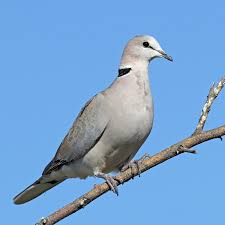Ring-Necked Dove

Description
The ring-necked dove (Streptopelia capicola), also known as the Cape turtle dove or half-collared dove, is a widespread and often abundant dove species in East and southern Africa. It is a mostly sedentary bird, found in a catholic variety of open habitats. Within range, its penetrating and rhythmic, three-syllabled crooning is a familiar sound at any time of the year. Its name is derived from the semi-collar of black feathers on the lower nape, a feature shared with a number of Streptopelia species. Like all doves they depend on surface water. They congregate in large flocks at waterholes in dry regions to drink and bathe.
Their body feathers are darkest on the upper side, where they are coloured in dull tones of grey and brown, with shades of lavender on the nape. It is paler below, where a tint of pinkish lavender is usually present. The lower belly and crissum (the undertail coverts surrounding the cloaca) is white. As with related species, they have white fringes and conspicuous white tips to the otherwise slate grey tail feathers. The tail pattern is particularly noticeable during the display flight.
Individual plumage variation is high, with some light and others almost sooty. Males and females look alike, although the males are slightly bigger. They measure 25–26.5 cm (9.8–10.4 in) in length and weigh 92–188 g (3.2–6.6 oz). The eyes are almost black, the bill is black and the feet are dark purple.
An immature is duller and lacks the semi-collar of an adult. It also has buff edges to all the upper part and wing covert feathers, while the plumage below is broadly edged greyish-white.
Scientific Name
Streptopelia Capicola
Country Of Origin
Africa
Size
Life Expectancy
Noise Level
Low
Characteristics
Athough they do enjoy spending time with other doves more than with people, some ring-necked doves may be tamed and will coo to their pet bird owners. The ring-necked dove is gentle and easy-going. Ring-necked doves are most commonly kept in aviaries and do well in mixed species aviaries.
Behavior / Health Concerns
Primarily seed eaters, ring-necked doves need grit in order to digest the seed. They can suffer from dehydration, so provide enough water for them. Ring-necked doves can be territorial, so place perches as well as a high, flat surface to roost on. Ring-necked doves enjoy seed mixes with milo, wheat and millet. Special treats can be served on occasion, such leafy green vegetables, broccoli, apples, boiled eggs, cooked rice, peanut butter and grated cheese. Breeders have created a plethora of color mutations that are recognized by the American Dove Association, and several other known mutation exist that are not recognized by the Association.